The climate in the room depends on the correct design! Features of the heating scheme of a two-story house

The heating season in Russia lasts on average about 5-6 months, the climate is harsh. An efficient and economical home heating device will save money and make your home comfortable to live in.
There are several options for constructing heating communications. Each has its advantages and disadvantages.
The general principle of heating systems is constant circulation of coolant (water, steam or antifreeze) in a closed system from the heating element (boiler) to heat consumers (radiators, convectors) while maintaining an acceptable temperature of the coolant.
Heating schemes for a two-story private house
There are several heating schemes for a private two-story house.
DIY Single Pipe Heating System
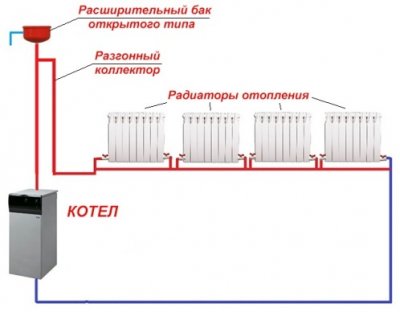
The scheme is distinguished by a smaller number of pipes, necessary for laying in the premises and ease of installation. At the same time, pipes of larger diameter are used, than with other heating methods.
This is necessary for less resistance to the flow of liquid. To use the scheme, the building must have an attic where the expansion tank will be installed and a basement for placing the water heater.
Structural elements of single-pipe heating:
- A device for heating heating liquid. The boiler acts in this capacity, and according to the heating method, it can be: gas, electric, or solid fuel.
- Heating mains: main riser, heating pipes connecting internal elements, return line.
- Heating radiators.
- Expansion tank to compensate for thermal expansion of the working fluid, must be sealed to prevent air from entering the system, and is installed at the highest point.
The heating system operates on the principle of either self-filling, or forced — using a connected pump. If a pump is used, the pipelines are installed without a slope.
The main riser pipe connects the boiler to the expansion tank vertically. Pipelines branch off from it on the floors, they are located at an angle to the horizon so that water can freely fill the system elements by gravity. The return pipeline allows the circulating liquid to flow to the starting point - the boiler.
The main difference of a one-pipe system is simplicity and reliability, absence of complex elements, and without a pump - silent operation.
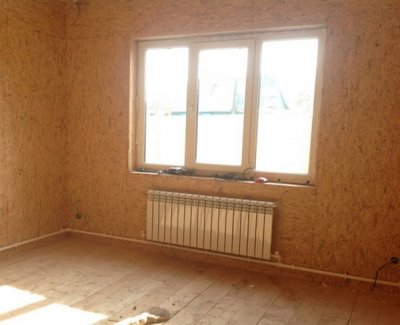
The downside of this design is that the inclined pipes in the rooms spoil the appearance and the second floor warms up better than the first.
Even when using a pump, heating efficiency will be lower than in other systems.
Another downside is high energy costs for optimal heating of the coolant, without which the air temperature in the rooms will be lower than comfortable.
It is not difficult to assemble the system yourself: by placing the heating radiators in the right places in the rooms, connecting them with plastic pipes and installing the boiler with the expansion tank vertically, relative to each other. Pipe joining technologies are available to non-professionals and will not cause difficulties.
Thus, it is advisable to use a single-pipe system. in small houses with small room areas, and also if the housing is not used for permanent residence all year round.
2-pipe heating system
The following design options are used: with both natural and forced circulation.
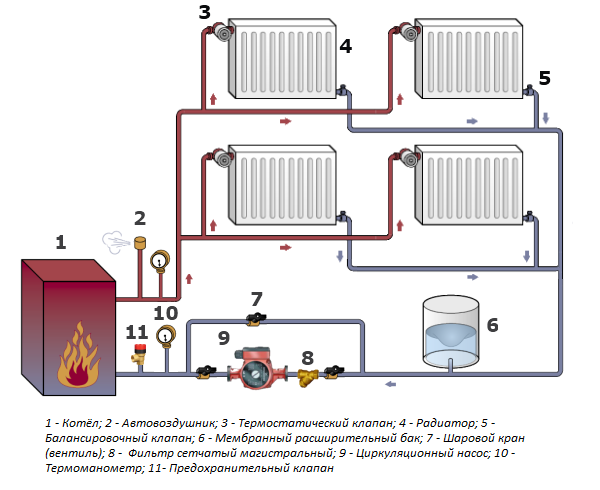
Photo 1. Diagram of a two-pipe heating system. The numbers indicate the components of the heating structure.
Device:
- Boiler for heating liquid.
- The pipeline for supplying the coolant (acceleration section), the largest pipe in diameter.
- Heating devices (radiators). Installed above the boiler level.
- Liquid return pipeline ("return").
It is possible to include a pump in the system.
If used passive circulation method of coolant, then the supply pipes must be higher than the radiators (“upper supply”) and installed at an angle.
The scheme differs in that each heat consumer is provided with separate supply of working fluid directly from the boiler and separate return of cooled coolant. That is, they are present two autonomous circuits: supply and return. Heat loss is possible only on the pipes themselves, which is “treated” by their additional thermal insulation.
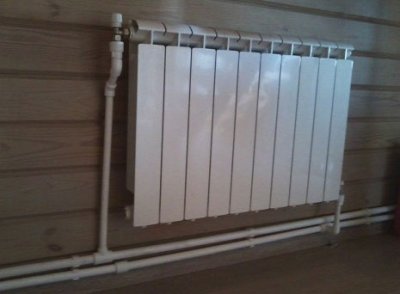
Closed and open systems used, differ in the properties of the expansion tank: hermetically sealed or not.
Open tank allows you to get rid of excess liquid and steam, obtained as a result of heating, you can make such a tank from improvised means, for example, a stainless steel container.
A characteristic feature is the need to monitor its fullness, otherwise air will enter the system.
A closed tank must maintain a certain pressure balance in the system., it is structurally more complex, independent production is hardly possible. But, with the correct calculation, spillage of the working fluid is excluded, which is significant when using expensive antifreeze.
Important! Modern factory boilers can be equipped with membrane type expansion tank. In this case, installing another tank is not required. But you will have to install additional gas vents to relieve excess pressure.
The advantage is Possibility of temperature adjustment for each consumer by installing additional thermostats. For example, if one of the rooms does not require strong heating.
The circuit is balanced, so does not require the use of powerful boilers, which means it is economical.
If it is necessary to replace any element of the system, there is no need to stop the entire complex, a separate radiator is shut off with taps and then dismantled.
Designing and assembling the system requires complex preparation and calculations., its cost is significantly higher, since more material is used (pipelines and fittings). And when using antifreeze as a working fluid, its volume is also twice as large as in single-pipe systems.
If a closed circuit with forced circulation is used, installation of measuring protective devices is required: pressure gauges, emergency safety valves at different points in the system circuits.
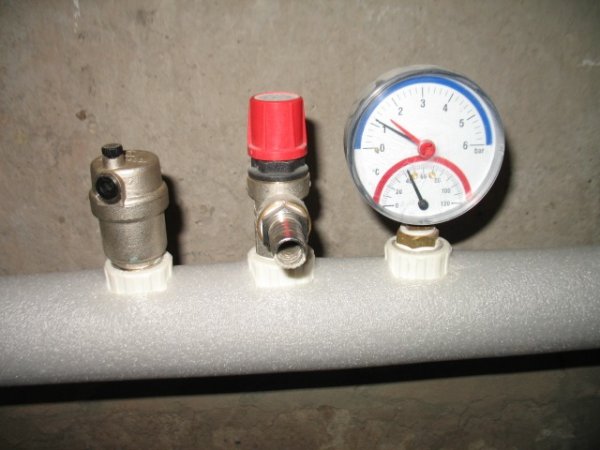
Photo 2. Manometer installed in a two-pipe heating system. The device allows you to measure the pressure in the structure.
The two-pipe system is simple and reliable, operates silently and does not require electricity (if the boiler is not in use), but There are also some downsides:
- radiators should not be located further than 30 m from the boiler;
- difficulties in calculations and installation - if installed incorrectly, there is a risk of too much resistance to the natural pressure, and the system will freeze;
- the pipes in the rooms are arranged so that it is not possible to hide them;
- average heating efficiency — a significant portion of the heat goes to providing passive circulation;
- system dependence on electricity, if forced circulation is used.
In order to independently implement a two-pipe system, you will have to spend time on precise calculations and creating a connection project, after which purchase the necessary materials and begin installation.
Collector heating system for a 2-storey house
This progressive heating system is equipped with a separate device for distributing the working fluid flow - collector unit. With its help, the coolant reaches consumers through separate circuits, and through return pipelines the cooled liquid returns to the collector and rushes back to the boiler.

Photo 3. Collector heating unit built into a special cabinet. In total, it includes five heating circuits.
The peculiarity is that the system is controlled from one place, distribution cabinet, which contains combs - plumbing elements with one input and several outputs.
Since the connection to each consumer is individual, small diameter pipelines can be used, the heating efficiency does not decrease significantly. Point control of each device allows smooth regulation of the climate in the house. Collector systems have the highest efficiency among all heating schemes.
Assembly principles:
- Installation of an automatic air vent, the valve “cuts” into the supply and return channels of the collector.
- The expansion tank volume should be 3-4% from the total volume of water.
- The expansion tank is installed in the return pipeline. in front of the circulation pump in the direction of liquid movement.
- Circulation pumps must be installed on each circuit., it is better on the “return”, where the temperature is lower, therefore, its operating efficiency will be higher.
Attention! The circulation pump is installed so that its working shaft is located horizontally, otherwise any potential air lock in the system will lead to the lubricant being washed out and the pump being damaged.
The disadvantages of collector systems include: the use of a large number of pipes and the need to use additional circulation pumps in the system.
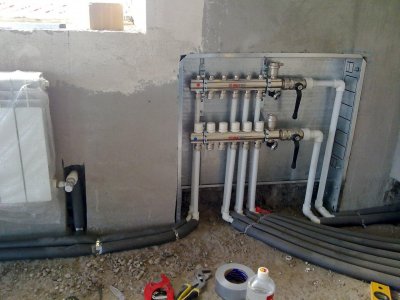
In addition, power outages, even if the boiler runs on gas or wood, will cause a stop in the heating supply to the house.
The liquid will not circulate properly without the necessary pressure in the pipelines.
It is very difficult to implement a collector system in premises independently, without the help of specialists. Experience in calculations and skill in laying out basic components is required. This is equivalent to installing complex electrical wiring in a house with a large number of consumers.
Without this, there is a risk of pointless investment of large funds and receiving an inoperative or potentially dangerous heating systemAnd all the alterations will result in even greater monetary costs.
Useful video
Watch a video that talks about the different types of heating systems with natural circulation for a two-story house.
A safe and efficient heating system is the work of professionals
Every owner can install heating in their home. But without special knowledge and experience there is a risk of getting a non-working one or an ineffective system. Instead of saving money, the home owner will spend even more money and personal time doing alterations and troubleshooting.
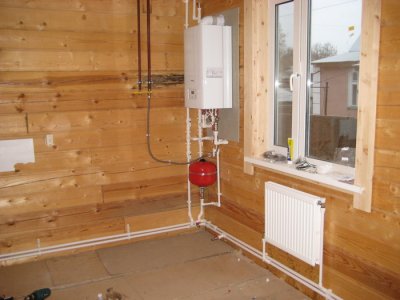
And homemade systems with forced circulation of the coolant are potentially dangerous.
If a pipeline ruptures, pressurized fluid can damage property and cause a fire.
When contacting companies that deal with heating systems, engineers will develop variations of heating schemes for a specific house, taking into account his individual characteristics.
It remains to choose an option based on financial capabilities. In addition, the company, having completed the work, will be able to take on the functions of servicing and preventing the heating system in the house.







Comments